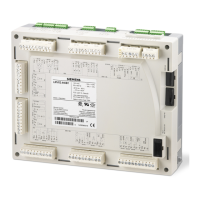TechnicalInstructions LMVSeries
DocumentNo.LV5‐1000
Section7 Page6 SCCInc.
FaultPositioningActuator–ErrorCode15
Anerrorcode15essentiallymeansthatanactuatorhasnotreachedthepositionitisbeingtold
todrivetobytheLMV5.Thediagnosticcodewilldetailwhichactuatorishavingtheproblem.
Ifanerrorcode15isencountered,checkforthefollowingcauses:
1. Binding.Atfulltorqueoutput,theactuatorcannotmovethevalveordamperitistryingto
move.Thisistypicallyduetotheactuatorpushi
ngagainstmechanicalstopsonthevalveor
damper.Checkthattheactuatorwasproperlycoupled.Thismayalsobecausedbyavalve
ordamperthatrequiresmoretorquethantheactuatoriscapableof.
2. Temperature.AllSQM…actuatorsareratedforamaximum
operatingtemperatureof
140°F.However,whenoperatingtemperaturesexceed120°F,thetorqueoutputofthe
actuatorisdecreasedby15%.Ifthisisthecase,reducetheheattotheactuator.
3. DutyCycle.AllSQM…actuatorsareratedfora50%dutycycle,meaningthattheactuator
canonlybemovinghalfofthetime.Dutycyclesover50%cancausetheactuatorto
overheatwhichreducesthetorqueoutputseve
rely.Iftheactuatorisconstantlymoving,
improvethePIDsettingsand/oradjustparameterMinActuatorStep.
4. Flutter.ThistypicallyoccursonairorFGRdampers.Highlyturbulentflowacrossadamper
bladecancauseanalternatingtorquetobeappliedtothedampershaft.
Thisinturnputs
analternatingtorqueontheactuatorshaft.Forexample,let’ssaythattheLMV5is
commandingtheairactuatortodriveto50.0°whichisahighlyturbulentspotontheair
damper.Thefollowingactionmaybeseen:
LMV5seesactuatorat50.3°andrepositionsitcounterclockwise
LMV5seesactuatorat49.7°andrepositionsitclockwise
LMV5seesactuatorat50.3°andrepositionsitcounterclockwise
LMV5seesactu
atorat49.7°andrepositionsitclockwise
Inthisscenario,eventuallytheLMV5determinesthattheactuatorcannotreachthe50.0°
positionandfaultswithanerrorcode15.Ifaflutterispresentontheairdamper,a
constanttorquecanbeappliedtotheairdamperassemblytoeliminatetheeffectsofthe
flutter.
5. Power.AlloftheactuatorsfortheLMV5runoffof24VACpower.Measurebetween
terminals12VAC1and12VAC2ontheactuatortoensure
thereareapproximately24VAC
providedtotheactuatorthroughoutthefiringrange.Iftherearenot,seeSection2forhelp
onCANbuswiring.Dependingontheloadrequirementsofthesystem,asecond
transformermaybenecessary.

